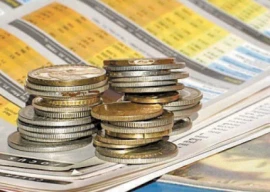
The interim government added Rs908 billion to public debt in November alone – the third-highest increase in a single month in this fiscal year, largely due to increased expenditures, pushing its overall debt to Rs63.4 trillion.
The State Bank of Pakistan (SBP) reported on Friday that the federal government’s debt increased to Rs63.8 trillion by the end of November 2023. The caretaker government added nearly Rs908 billion to the debt stock in a single month, marking the third-highest increase in debt this fiscal year.
The revised debt numbers for July 2019 showed that the Pakistan Democratic Movement (PDM) government had included Rs936 billion in its last month in power, Rs29 billion higher than the provisionally reported figures. The highest increase in public debt this fiscal year was Rs2.2 trillion in August, mainly due to a Rs19 per dollar devaluation in that month.
The Rs908 billion increase in public debt was Rs328 billion more than the provisional federal budget deficit booked in November, according to government sources.
A major surge in public debt was on the domestic front. Out of Rs908 billion, an amount of Rs546 billion was added to the domestic debt stock. The increase in external debt in a single month was Rs361 billion, including the impact of rupee devaluation. The rupee-dollar parity by the end of November stood at Rs285.24 per dollar – up by Rs3.72 per dollar from the preceding month.
Public debt has been multiplying at an unsustainable pace due to uncontrolled expenditures, below-potential revenue collection from sectors like real estate, services, and agriculture, and the sinking rupee against the dollar.
The federal government’s expenditure surged to Rs4.83 trillion in five months due to an unmanageable interest cost and a slight opening of the public purse for other spending. Finance ministry sources said that the tight control maintained over expenditures until October was slightly relaxed in November, resulting in about a Rs580 billion jump in the federal budget deficit in just one month.
During the July-November period of this fiscal year, total federal government expenses rose to Rs4.83 trillion, marking an increase of nearly Rs1.5 trillion or 43% compared to the same period last fiscal year.
Interest payments during July-November skyrocketed to Rs2.92 trillion, a 75% increase compared to the same period last fiscal year.
Overall, federal government debt jumped from Rs51 trillion a year ago to Rs63.3 trillion – an increase of Rs12.4 trillion or one-fourth within a year. The SBP bulletin showed that the external debt of the federal government rose at a pace of 25% to Rs22.4 trillion in one year. There was a net increase of Rs4.5 trillion in external debt, largely due to currency depreciation and the revival of foreign lending.
At the end of November 2022, external debt stood at Rs18 trillion, excluding IMF liabilities. Pakistan received major loans from multilateral and bilateral creditors in July. The share of external debt in the total debt is over 35%, and any movement in the exchange rate leaves a major impact without even borrowing a single dollar.
In November 2022, the rupee-dollar parity was at Rs224, which depreciated to Rs285.3, a drop of Rs61, or 27%, in just one year. Such a large and steep depreciation also fuelled inflation in the country. Lately, the rupee is making recoveries on the back of tight control on imports.
Read Govt rejects absorbing PIA’s Rs263b debt
The federal government’s total domestic debt increased to Rs41 trillion, an addition of Rs8 trillion (or 24%) in the past one year.
A direct consequence of the mounting debt is a huge increase in the cost of debt servicing. Debt servicing is expected to stay around Rs8.5 trillion during the current fiscal year – far higher than the government’s budgeted amount.
In a high-interest rate environment, the federal government is heavily borrowing on a long-term basis, revealed the SBP bulletin. The share of long-term debt within one month increased from Rs31.3 trillion to Rs33.2 trillion – a surge of Rs1.9 trillion.
Prudent debt management warrants fewer longer-tenor borrowings when interest rates are at their highest levels and are expected to reduce short-term.
However, the government’s borrowings against short-term instruments have reduced in November compared to the preceding month. In October, the stock of short-term domestic debt was Rs9 trillion, decreasing by 15% to Rs7.6 trillion in November – a reduction of Rs1.4 trillion.
This will significantly increase the cost of the debt burden of the government, as the finance ministry is making attempts to show less debt servicing cost in this fiscal year through longer-term borrowings.
In the budget, the government had set aside Rs7.3 trillion for interest payments despite internal workings showing the cost at around Rs8.3 trillion. The IMF has now projected the interest cost at over Rs8.6 trillion.
Published in The Express Tribune, January 6th, 2024.
Like Business on Facebook, follow @TribuneBiz on Twitter to stay informed and join in the conversation.










1731570357-0/elon-musk-(1)1731570357-0-270x192.webp)

















COMMENTS
Comments are moderated and generally will be posted if they are on-topic and not abusive.
For more information, please see our Comments FAQ